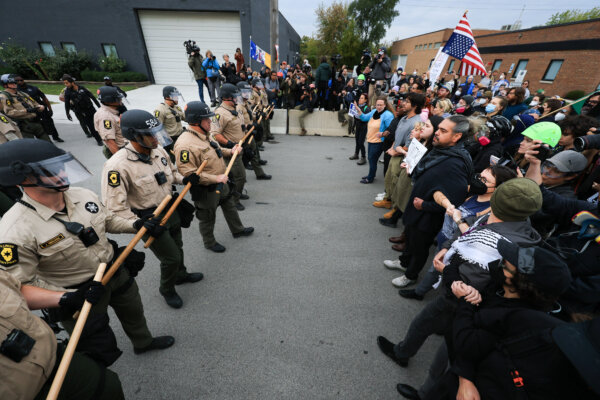Update (1423ET):
Kerr County Sheriff Larry Leitha confirmed in a news conference that at least 90 people are dead and dozens are still missing after a 30-foot wall of water surged down the Guadalupe River late last week.
Of the fatalities so far, 75 have occurred in Kerr County, Leitha said, adding that the dead include 48 adults and 27 children, with 15 of the adults and nine of the children unidentified. Camp Mystic, located along the Guadalupe River in Hunt, Texas, confirmed that 27 children and counselors died in the flooding.
“Our hearts are broken alongside our families that are enduring this unimaginable tragedy. We are praying for them constantly,” Camp Mystic wrote in a statement, adding, “We have been in communication with local and state authorities who are tirelessly deploying extensive resources to search for our missing girls. We are deeply grateful for the outpouring of support from the community, first responders, and officials at every level.”
At least 10 Camp Mystic children are still missing, along with one counselor, the sheriff noted. Separately, White House press secretary Karoline Leavitt confirmed that President Trump will travel to Kerr County, but did not provide specifics about the timing.
“President Trump loves you. We are praying for you, and he will be traveling to see you later this week,” Leavitt said during today’s press briefing.
* * *
The flash flood that sent a 30-foot wall of water surging down the Guadalupe River in Central Texas has claimed at least 81 lives as of early Monday morning. Law enforcement officials in Kerr County confirmed that at least ten girls from Camp Mystic remain missing. Amid speculation that the so-called “1-in-1,000-year storm” may have been triggered by cloud seeding, one of the weather modification operators in the region has denied any flight operations during the relevant timeframe.
On Sunday, Texas Governor Greg Abbott (R) warned that another round of storms could bring additional danger to the region over the next one to two days. The flooding across Central Texas is shaping up to be one of the deadliest freshwater flood events in the U.S. over the past half-century, with the death toll likely to surpass the 84 lives lost in the 1977 Johnstown, Pennsylvania flood.
“There’s the potential for flash flooding, but there’s no expectation of a water wall of almost 30 feet high,” Gov. Abbott told reporters.
Local, state, and federal officials have outlined plans to expand search and rescue operations throughout Kerr County. Meanwhile, National Weather Service officials pushed back against claims by corporate media about staffing shortages. The White House’s response to those claims was described as “disgusting.”
Intense scrutiny has fallen on Rainmaker Technology, a California–based weather modification startup, amid speculation that cloud seeding may have contributed to the historic flooding.
CEO Augustus Doricko responded to baseless claims on X by saying, “Rainmaker did not operate in the affected area on the 3rd or 4th or contribute to the floods that occurred over the region.”
The natural disaster in the Texan Hill Country is a tragedy. My prayers are with Texas.
Rainmaker did not operate in the affected area on the 3rd or 4th or contribute to the floods that occurred over the region.
Rainmaker will always be fully transparent. https://t.co/J5QlUbruCd
— Augustus Doricko (@ADoricko) July 5, 2025
Doricko continued:
Overnight from July 3rd – 4th, moisture surged into the Hill Country from the Pacific as remnants of Tropical Storm Barry moved across the region. At 1:00 a.m. on July 4th, the National Weather Service (NWS), which we work closely with to maintain awareness of severe weather systems, issued a flash flood warning for San Angelo, Texas. Note, summer convective cloud seeding operations in Texas do not occur during overnight hours. At 4:00 a.m. on July 4th, the NWS issued a life-threatening emergency warning, and flooding ensued.
Did Rainmaker conduct any operations that could have impacted the floods? No. The last seeding mission prior to the July 4th event was during the early afternoon of July 2nd, when a brief cloud seeding mission was flown over the eastern portions of south-central Texas, and two clouds were seeded. These clouds persisted for about two hours after seeding before dissipating between 3:00 p.m. and 4:00 p.m. CDT. Natural clouds typically have lifespans of 30 minutes to a few hours at most, with even the most persistent storm systems rarely maintaining the same cloud structure for more than 12-18 hours. The clouds that were seeded on July 2nd dissipated over 24 hours prior to the developing storm complex that would produce the flooding rainfall.
A senior meteorologist observed an unusually high moisture content prior to the event’s arrival, using NWS sounding data. It was at this point that our meteorologists determined that we would suspend future operations indefinitely. As you can see, we suspended operations on July 2nd, a day before the NWS issued any flood warning.
Here are the flight logs for July from our South Texas Program
And more:
I encourage the meteorology community to ask questions and scrutinize our claims, and we will continue to be fully transparent in answering.
Attached is a meteorological report on the events. pic.twitter.com/zyuamIygg8
— Augustus Doricko (@ADoricko) July 5, 2025
Related:
Other weather news:
. . .
Loading…













